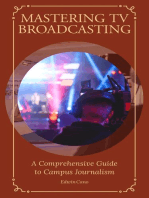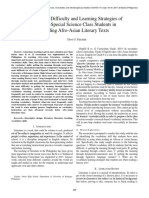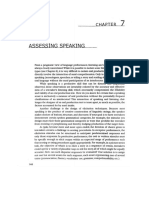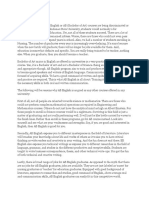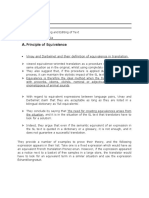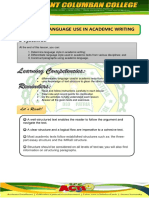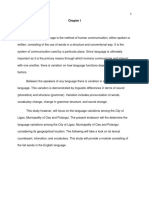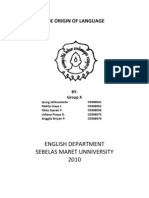Transcription Theory
Transcription Theory
Uploaded by
Udiana Puspa DewiCopyright:
Available Formats
Transcription Theory
Transcription Theory
Uploaded by
Udiana Puspa DewiOriginal Description:
Copyright
Available Formats
Share this document
Did you find this document useful?
Is this content inappropriate?
Copyright:
Available Formats
Transcription Theory
Transcription Theory
Uploaded by
Udiana Puspa DewiCopyright:
Available Formats
LG654 Sociolinguistics Method II (Dr.
Vineeta Chand)
Udiana Puspa Dewi, MA Sociolinguistics
University of Essex (2014)
Transcription Theory
Udiana Puspa Dewi, MA Sociolinguistics
University of Essex
2014
A. Introduction
The issues about transcription have become an important topic which is talked about by
several researchers, especially related to its role in qualitative research. A lot of researchers take
the role of transcription in qualitative research for granted. But Kvale (1996) points out that,
transcription is not just a process of notating symbols; it is a process of choices and selection to get an
intended result to support the aim of the research. Thus, this paper is intended to perform the
theoretical views about transcription from previous studies to see the functions and goals of
transcription and how the choice in transcribing should be made. I will present three features in
transcription in two different ways to see how the goals of transcribing impact to the function of
transcription results.
B. Theoretical Views of Transcription
There are various perspectives used to see how transcription is defined. Davidson (2009)
sums up some definitions of transcription from several perspectives; conversation analysts have
defined transcription as situated practice (Mondada, 2007) that provides accounts of a social and
moral order (Baker, 1997). From the perspective of linguistic anthropology, transcription can be
viewed as cultural practice or cultural activity and transcripts as artifacts that possess temporal-
historical dimensions (Duranti, 2007, p. 302). From within sociolinguistics, transcription has
been defined as a political act (Green, Franquiz, & Dixon, 1997) whereby the recording of
speech reflects transcribers analytic or political bias and shapes the interpretation and
evaluation of speakers, relationships and contexts depicted in the transcript (Jaffe, 2000, p.
500).
Transcription is one of essential part of qualitative research in linguistics research. Ochs
(1979) argues that transcription is an important part of research because one of the
consequences of ignoring transcription procedure is that researchers rarely produce a transcript
LG654 Sociolinguistics Method II (Dr. Vineeta Chand)
Udiana Puspa Dewi, MA Sociolinguistics
University of Essex (2014)
that does reflect their research goals and the state of the field. From that statement we can see,
that it is important to set a goal and determines what is important to be revealed in the
transcription.
The functions of transcription in a research are also differently implicated by some
researchers. Ochs (1979) has an argument that transcription is functioned as data to be analyzed
in a research. But, other researchers argue that transcription is not just a data. Bucholtz and Du
Bois (2006) state transcription should be developed as analytical tools and theoretical resources
to fulfill the research needs. From different perspective, Hutchby and Wooffitt (1998: 73) argue
that the principle features of talked performed in transcripts are almost all involved in particular
analytic issues, thus transcription is seen as procedure of analysis within a research.
Related to the goal of transcription, Bucholtz (2000) mentions that the choices made in
transcription link the transcript to the context in which it is intended to be read. Embedded in the
details of transcription are indications of purpose, audience, and the position of the transcriber
toward the text. Transcripts thus testify to the circumstances of their creation and intended use.
This statement is in line with Ochs (1979:44) who states about how important selectivity in the
transcription. She assumes that more selective a transcript, more useful it is. This is related to the
fact that it is impossible to capture all of the aspects and features from the recording into a
transcript.
From those theoretical statements, it can be seen that the main focus of the research
becomes a serious consideration in the proses of transcription. Therefore, framework and goal of
transcription should be made before the transcription process is done to be able to capture the
context and other data needed for the research. In the next part, I will demonstrate the use of
different presentation of features in transcription and its implication.
C. Choice of Transcription Presentation
In this part, I will perform two different presentation of transcription of three linguistics
features. Choice of transcription presentation is important, as it is stated by Bucholtz (2000) that
choices on how talk is represented in transcript reveal power relation which has been explored in
many sociolinguistic literatures.
LG654 Sociolinguistics Method II (Dr. Vineeta Chand)
Udiana Puspa Dewi, MA Sociolinguistics
University of Essex (2014)
My data is the interview of Monica Lewinsky which was done by Barbara Walter in
ABC's 20/20 aired on March 3, 1999. The topic of interview is about the scandalous relationship
between Bill Clinton and Monica Lewinsky. Based on the interview, I think there are interesting
features that can be analyzed in sociolinguistics, discourse analysis, or conversational analysis.
The features that I used to demonstrate the implication of transcription here are hesitation,
intonation, and interruption.
1) The presentation of hesitation through pause in the transcript
Presentation 1 Presentation 2
IV : Monica, you have been described as a-- a
bimble, a stalker, a seductress. Describe
yourself!
ML : I think Im um, // Im very loving, / Im
very loyal/, mmm, I think Im intelligent
(laughing). I think I certainly feel, that
Im, - - I have been misportrayed, in the
past year and then fairly show
IV : Monica, you have been described as a
--a bimble, (1.3) a stalker, (1.9) a
seductress (1.4) describe yourself!
ML : I think Im um, (2.3) Im very loving,
Im very loyal, mmm, I think Im
intelligent (laughing). I think I
certainly feel, that Im, - - I have been
misportrayed, in the past year (1.2)
and then fairly show
Duration of pause in a conversation captures an important fact about the reality. As it is
stated by Ephratt (2008) that pause is one of strategies that commonly used in
communication. That is why it is important to consider how to capture pause and its duration
within a transcription to reflect the context, power relations, and other facts surrounding the
conversation. The two transcriptions above demonstrate how pauses are performed in two
different ways. The first transcription considers more on readability and the second one
concern on accuracy. To main focus of those two transcriptions is to capture hesitation in the
conversation.
The transcription on the right side performs the pause by using ( / ), one (/) representing 1
second pause. On the left side, the pause length of pauses is stated implicitly in the
transcription. The length of pause is measured by using stopwatch. From the comparison, it
can be seen that the transcript on the right side is easier to read because it has simpler form
and less explanation. But the transcript on the left side is considered to be more accurate,
because it measures the length of the pause more accurately. In the right table, the pause has
to be 1 or multiply of 1 second. That will be problematic when the pause is 1.5 or 1.75
second, because then the transcriptor should decide to put (/) or (//).
LG654 Sociolinguistics Method II (Dr. Vineeta Chand)
Udiana Puspa Dewi, MA Sociolinguistics
University of Essex (2014)
On the right transcription, the pause captured on the transcription only those which are
the reflection of hesitation. On the left side, every pause which is more than 1 seconds is
captured in the data. The transcription structure on the right side is related to what is stated
by Ochs (1979) as selectivity, it might not as accurate as the left side transcription, but it
capture what is needed for the research. Therefore, the transcription on the right table is seen
as an analysis procedure (Hutchby & Wooffitt, 1998) because the transcriptor did the
analysis of selecting which pause is considered as hesitation expression and which one is not
while transcribing the data. On the left side table, transcription has a function as analytical
tool (Bucholtz & Du Bois, 2006) because the analysis is done after transcription, based on
the result of the transcription. The transcription is used as a tool to consider which pauses are
considered as hesitation.
2) The presentation of intonation
Presentation 1 Presentation 2
IV : And on that day, you found yourself
alone with Bill Clinton in the chief
desk office, and you lifted the back of
your jacket, and you show the
president of the United State, your
thong underwear.
ML : (laughing)
IV : WHERE DID YOU GET THE
NERVE?! I mean, Who does
IV : And on that day, you found yourself
alone with Bill Clinton in the chief
desk office, and you lifted the back of
your jacket, and you show the
president of the United State, your
thong underwear.
ML : @@
IV : Where did you get the nerve? (raise
intonation) I mean, Who does
(unfinished)
Capturing intonation in a transcript is somehow a little bit complicated. It is important to
capture intonation in a conversation because intonation plays important role in revealing the
reality and the context of the conversation. There are two different presentations of three
features in the data above; the laughter, raising intonation, and unfinished intonation.
The laughter in the right side table is just written explicitly, while in the left side, it is
written on @ mark. Each of @ mark represents one pulse of laughter. The choice of the
presentation, again, will be based on the research aim. The left side of course has more detail
and accuracy in describing laughter, but if the duration of the laughter is not important for the
research analysis, the right side transcription will be better because it can be read more
easily.
LG654 Sociolinguistics Method II (Dr. Vineeta Chand)
Udiana Puspa Dewi, MA Sociolinguistics
University of Essex (2014)
On the right side transcription, the raise intonation is performed through the capital letters
and the exclamation mark (?!). On the left side, it is performed through the exclamation mark
and the explanation in the bracket. The presentation in the right table is simpler, but maybe
some people need to read the explanation to know the meaning of the capital words used in
the utterance. It is easier to understand the intonation in the left table because it writes the
detail of the explanation within the transcription. Same thing happens with the unfinished
intonation presentation, in the right transcription it is represented by () while in the left
transcription it is explicitly stated.
In both transcripts, it can be seen that, not all of the sentences have detail explanation
about the intonation. It is based on the selectivity principle that only those salient intonations
which have important contribution in the data interpretation are performed into the transcript.
3) The presentation of interruption
Presentation 1 Presentation 2
ML : (deep breath) It was certainly a very, I
mean, intimate topic, um, (long
pause) there was a level of excitement
about that, um, excitement in maybe a
little bit of danger that was involved
in this relationship and to-- to pretend
that there wasnt when it be trustful
IV : didnt it make you feel cheap?
ML : No, it didnt, it did not, not at that
point. No.
ML : (deep breath) It was certainly a very, I
mean, intimate topic, um, (long
pause) there was a level of excitement
about that, um, excitement in maybe a
little bit of danger that was involved
in this relationship and to-- to pretend
that there wasnt when it be trustful
(IV cut: didnt it make you feel
cheap?) No, it didnt, it did not, not
at that point. No.
Green and Dixon (1997: 173) state that the important things in transcription are: what is
represented in the transcript (e.g., talk, time, nonverbal actions, speaker/hearer relationships,
physical orientation, multiple languages, translations); who is representing whom, in what
ways, for what purpose, and with what outcome; and how analysts position themselves and
their participants in their representations of form, content, and action. That is why
presenting interruption in the transcription is important, because it reveals how the speakers
positioned themselves in the speaker/hearer relationships.
The different presentation of the interruption in the two tables above lies on the way the
interruption from the interviewer positioned. On the right side transcription, the interruption
is performed through the use of () at the end of the sentence being interrupted and at the
LG654 Sociolinguistics Method II (Dr. Vineeta Chand)
Udiana Puspa Dewi, MA Sociolinguistics
University of Essex (2014)
beginning of the interruption sentence. The interruption sentence does not use capital letter at
the beginning to show that it is an interruption of another sentence from the previous speaker.
In the left table the interruption sentence is inserted in between the interviewee sentences. It
also stated explicitly that the interviewer cut the sentence. The interruption sentence is
written in italic to make it easier to see that there are two different speakers in that one long
passage.
In the case of readability, the transcription on the right side is easier to be read because
the interviewer and the interviewee utterances are separated in two different lines. Both has
the same level of accuracy, but the presentation on the right side still looks more proper and
clearer to be presented in a paper.
D. Transcription Protocols Comparison
The two transcription protocols that I compare in here are transcription protocols from
MUSL (Memorial University Sociolinguistics Laboratory) and AAALC (Automatic
Alignment and Analysis of Linguistics Change). There five goals of MUSL transcription
protocol summarized by Gerard Van Herk (2012); 1) accurately captures variation in
morphology, syntax, and word choice, but not details of pronunciation, 2) searchable
document, 3) getting work done (not to spend time on small and unnecessary thing), 4)
readable document. The AAALC protocol is the adaptation of The SLX Corpus of Classic
Sociolinguistic Interviews of Linguistic Data Consortium. This protocol has similar goals
with MUSL protocols. MUSL has more detail in identifying recording and participant that it
has rules how to name the recording file and how to identify the speaker in transcription.
Both of protocols do not have clear details on the pause, overlapping, intonation, and
stress. The MUSL uses () to represent pause, but it is not clearly mentioned about the
pause duration. That is why in the transcription I modified the protocols by using additional
information such as (breath) to show that someone is taking a deep breath, () to show that
someone pause for 1 second. So if the speaker pause for 2 seconds, the representation will be
(). I also used (,) to show that someone pause in less than 1 second but more than 0.5
second, capital words to show stressed intonation, and the use of [ ] to show that the
utterance inside the bracket is an overlapping utterance. AAALC also does not have specific
LG654 Sociolinguistics Method II (Dr. Vineeta Chand)
Udiana Puspa Dewi, MA Sociolinguistics
University of Essex (2014)
rules for pauses, reported speech, and overlapping speech like MUSL. That is why I modified
the AAALC in my protocol by adding the same rules like I used in MUSL in representing
pause, and stressed intonation. In AAALC, I used [ ] to represent the speech turn cut by other
speakers. In MUSL the cutting is represented the same way as the false start. I applied the
MUSL rule in reported speech in AAALC transcription because AAALC does not have
specific rule for reported speech.
The most salient differentiation of these two protocols is the way they represent the non-
standard features. In MULS the non-standard feature is represented in standard orthography
but type it in italic, while in AAALC the non-standard feature is represented in transcribe
what is spoken, not what they expect to hear. But AAALC has special rule for
mispronounced word, it is represented by in standard orthography but with an asterisk *.
From the comparisons above, it can be concluded that MULS transcription protocol is
better than AAALC because it has more detail and distinction in representing the details of
interview in the transcription. Both of transcription protocols do not fit for phonological
research because they do not reveal detail of pronunciation. They are also not good in
conversational analysis because they do not represent pause, intonation, overlapping, speech
turn and contextual situation of the interview in clear way. As it is stated previously, these
transcription protocols are best to use in observing morphology, syntax, and word choice
aspects of an interview.
E. Conclusion
Based on the explanation and presentation about transcription above, it can be concluded
that the important thing in transcribing process is selectivity. It is impossible to capture
everything that happens during the interview, thus the goal and main focus of the transcription
should be made before starting the process. After deciding the goal, it will be easier to decide
which part should be revealed and which part should be muted within the transcription. The
function of the transcription will be seen from the way the transcript is presented. The researcher
might use the transcript as a data (Ochs, 1979), the analysis process (Hutchby and Wooffitt,
1998), or the analytical tool (Bucholtz and Du Bois, 2006).
LG654 Sociolinguistics Method II (Dr. Vineeta Chand)
Udiana Puspa Dewi, MA Sociolinguistics
University of Essex (2014)
References
Bucholtz, M. (2000). The politics of transcription. Journal of Pragmatics, 32(2000), 14391465.
Bucholtz, M., & Du Bois, J. (2006). Transcription issues in current linguistic research. Paper
presented at the Linguistic Society of America 80th Annual Meeting, Albuquerque, New
Mexico.
Davidson, C. 2009. Transcription: Imperatives for Qualitative Research. International Journals
for Qualitative Methods, 8 (2009) 35-52
Ephratt, M. The function of silence. Journal of Pragmatics 40 (2008) 19091938
Green, J., Franquiz, M., & Dixon, C. (1997). The myth of the objective transcript: Transcribing
as a situated act. TESOL Quarterly, 21(1), 172176.
Herk, G. V. (2012). Transcription protocol: memorial university sociolinguistics laboratory.
http://www.musl.ling.mun.ca
Hutchby, I., & Wooffitt, R. (1998). Conversation analysis: Principles, practices, and
applications. Malden, MA: Polity.
Kvale, S. (1996). Interviews: An introduction to qualitative research interviewing. Thousand
Oaks, CA: Sage.
Ochs, E. (1979). Transcription as theory. In E. Ochs and B. B Schiefflin (Eds.), Developmental
pragmatics (pp. 4372). New York: Academic.
Video source: http://www.youtube.com/watch?v=fpCv-UT2yCU
LG654 Sociolinguistics Method II (Dr. Vineeta Chand)
Udiana Puspa Dewi, MA Sociolinguistics
University of Essex (2014)
APPENDIX
Transcript Protocols
MUSL AAALC
Identifying
interview
State at the beginning of the transcription
neighborhood, speaker name, speaker
code/number, speaker sex, speaker age,
initials or name of participants, other
participants, other participants sex, actual
tape numbers of the whole interview,
transcription #
Full names (full name
and last name - just full
names are okay)
Specific addresses
(many people talk
about where they live
or grew up)
Identifying
speaker
Create your own speaker code or use [001]
for the first speaker and [I] for interviewer
-
Naming the
document
<community>_speaker_<speakercode>_<interviewdate>.doc
-
False starts Whole word: Its funny that-
Partial word: Its funny th--
Whole word:
Since she -- when she died
we moved from across the
street.
Partial word:
Yes, absolu- +absolutely
absolutely.
Discourse
markers
You-know
I-mean
no special markup
uh-huh, yeah, mhm
Names Jerry-Boyle
Mile-One-Centre
-
Spelling/
abbreviation
Lower case for spelling word: c-a-t
Upper case for abbreviation: D-K-N-Y
Spelling letters should be
written in all caps, with
each individual letter
surrounded by spaces.
example:
I'll stop in to get my U P S
packages.
Abbreviation no specific
mark up: UPS
Numbers Spell out numbers up to ten; use numerals
for anything larger. Exception: spell out
larger numbers when preceded by a
(there must have been a thousand of them).
All numerals are written
out as complete words.
Hyphenation is used for
numbers between twenty-
one and ninety-nine only
Legal hesitation um, ah, oh (restricted into these three)
ah, eh, er, uh, um
(restricted into these five
items)
LG654 Sociolinguistics Method II (Dr. Vineeta Chand)
Udiana Puspa Dewi, MA Sociolinguistics
University of Essex (2014)
Fillers eh? (question (often tag))
eww (expressing distaste)
hm? (question)
huh (question filler)
jeez (exclamatory)
luh (meaning look, you-know, etc.)
mm (1 syllable filler meaning yes)
mm-hm (2 syllable filler meaning yes)
ooo! (expressing surprise)
ouch! (expressing pain)
oops! (exclamatory)
phew (relief)
shh (telling someone to be quiet)
uh-huh (2 syllable filler meaning yes)
uh-uh (2 syllable filler meaning no)
whoa! (exclamatory)
whoosh! (as if straight over someones
head, ignoring someone)
wow (expressing awe)
yeah (meaning yes)
yup (meaning yes)
yes (meaning yes)
yay! (excitement)
duh
eee
ew
ha
hee
huh
huh-uh (neg.)
hm
jeepers
jeez
mm
mhm (pos.)
nah
oh
ooh
uh-huh (pos.)
uh-oh
whoa
whew
whoops
yay
yeah
yep
yup
Pauses Use an ellipsis () -
Punctuation and
spelling
Every complete sentence must end with
punctuation.
(, ? ! . ") limited to these
five symbols
Reported speech Shes like, I totally dont want to do this.
Im thinking, No way Im going in there.
-
Non-standard
variation/variation
Represented in standard orthography but
type it in italic
Words that are used in a
non-standard way:
annotators should
transcribe what is spoken,
not what they expect to
hear.
Mispronunciation - Represented in standard
orthography but with an
asterisk *
Example: What *picture?
Overlapping
speech
If two people talk at the same time, try to
maintain a full sentence for each speaker:
[X] My favourite flavour is vanilla.
[i] Vanilla.
-
Cutting Speech
Turn
Represented as false starts -
LG654 Sociolinguistics Method II (Dr. Vineeta Chand)
Udiana Puspa Dewi, MA Sociolinguistics
University of Essex (2014)
Background
noises/
background
conversation
[F] (on phone) Hi, Mom! <Transcribe
whole conversation>
[F] (off phone) Sorry about that.
Laughter is typed into (laughter)
{BR} breath (The speaker
takes an audible breath.)
{CG} cough (The speaker
coughs, or clears his/her
throat.)
{LS} lip smack (The
speaker smacks his/her
lips.)
{LG} laughter (The
speaker laughs.)
{NS} noise (Loud
background noise, e.g. a
door slamming, cars
honking etc.)
Unclear or
unintelligible
speech
Type (inc), meaning incomprehensible.
You can put guesses in the parentheses,
too: [X]
They lived ((next door to
us)).
LG654 Sociolinguistics Method II (Dr. Vineeta Chand)
Udiana Puspa Dewi, MA Sociolinguistics
University of Essex (2014)
MUSL Transcription
Neighbourhood : -
Speaker name : Monica Lewinsky
Speaker code/number : 001
Speaker sex : Female
Speaker age : 25 years old
Initials : ML
Interviewer : Barbara Walter
Interviewer code : I
Interviewer sex : Female
Interviewer age : 70 years old
Tape numbers : 1
Transcription number : #1
FILE NAME FOR THE DOCUMENT: Monica Lewinsky_<001>_<03031999>.doc
[I] Monica, you have been described as a - a bimble, a stalker, a seductress, describe yourself!
[001] (breath) I think Im um, Im very loving, Im very loyal, um, I think Im intelligent (laughter). I
think I certainly feel, that um, I have been misportrayed, in the past year, and then fairly so.
[I] This is the first time that you have really been able to speak out and say pretty much, anything
you wanted to say. Is there something that you particularly do wanna say at this point?
[001] Yes! (breath) um (pause) I really waited long time, to be able to express to the country how
very sorry I am for my part in this past years or deal. And, um, of course, Ive- Ive apologized
in private to my family and to my friends, but I would like to publicly acknowledge that I- I
recognize the pain, and the suffering that theyve gone through because of this, um, I- (breath) I
wouldnt dream of asking Chelsea and Mrs. Clinton to, forgive me, but I would ask them to know
that I AM very sorry for what happen and for what theyve been through.
[I] Do you take responsibility for what happen?
[001] Not complete responsibility, it took me awhile actually t-- to come to a place where I can see
what was my fault, what did I need to take responsibility for, and what were other peoples fault
and responsibilities.
------------------------------------------------------ (News Narration)------------------------------------------------------------
[I] While youre in high school, and then in collage-
[001] uh huh
[I] you had an affair, with a-- a man who worked at you high school, named Andy Blyler. It was on
again, of again, I-mean, you really, care about him and eventually when the story broke he
turned against you. And that was probably very painful. But, CAN you describe, what Andy Blyler
meant in your life?
[001] Um, yes, (breath) Andy came, into, my life at, um, in a very- during very difficult period for me. I
was, um, have always had issues with my weight that is not a secret to anybody now.
Andgrowing up in Beverly Hills, having a weight problem, is just not acceptable, and, Andy,
LG654 Sociolinguistics Method II (Dr. Vineeta Chand)
Udiana Puspa Dewi, MA Sociolinguistics
University of Essex (2014)
brought to my life, um, a feeling of beauty, and, sensuality, and, being wanted, and being
comfortable with myself. He brought something I think which is a big part of who I am, today,
which is for me, and I know its funny, but its being comfortable with my sensuality, so
(unfinished)
[I] One juror, at grand juries, asked you why are kept having affair with a married man. Why did
you? WHY DO YOU?!
[001] I have to say that was, the most difficult question in my entire, experience with the grand jury. It
was the most pointed question, um, first I hope I never will have, I KNOW, I never will have
affair with married man again. Um, I have to pray about that, but, clearly, to me, when I come to
see, is th- that happen because I didnt, have enough feeling of self-worth, so that I didnt feel
that, um, I was worthy of being number one, to, a man. And, um-
[I] Do you have to take whatever you can get?
[001] mm-hm
[I] You came to Washington as an intern, were you interested in politics?
[001] No, I wasnt. I was looking to, get away from Andy (laughter) in Portland. And it, um, it was a
good opportunity, I thought it would be intriguing.
[I] You justified that shortly after your internship began, that you and the president began what
you describe as INTENSE FLIRTING. When did you see him? What was this intense flirting like?
[001] The, um, th-- the first time I saw him was at an arrival ceremony, and I was I- I mean my- my
breath was taken away, I mean, he short of step out onto th-- the platform and it was this, man
who was full, of energy, and, sensuality, and attractiveness. And, from that moment on, the
view occasions when I saw him, at departure ceremonies or whats not there was, um, there
was an intense eye contact. (laughter)
[I] This photograph, was taken, before you actually began your relationship with the president.
[001] Mm
[I] Yes?
[001] Yes
[I] What this is bring to you? What, thoughts?
[001] Mm Intensity, um-
[I] He recognizes you here, hes looking at-
LG654 Sociolinguistics Method II (Dr. Vineeta Chand)
Udiana Puspa Dewi, MA Sociolinguistics
University of Essex (2014)
[001] This was, um, (breath) uh, this was his birthday party, in August of 95. When I found out were
gonna be able to go to his birthday party, I gone home and put my lucky green suit back on
which I had a day before and I thought, maybe hell recognize me again. And it was, there was
an excitement about it. It was, um, it was fun.
[I] Okay, you had this flirtation, with the president, that mostly public affair, in a place where the
birthday party other things. November 15, 1995, the government to shut down,
[001] Mm-hm
[I] The interns take on gradual responsibility on the White House. And on that day, you found
yourself alone with Bill Clinton, in the chief desk office, and you lifted the back of your jacket,
and you show the president of the United State, your thong underwear.
[001] (laughter)
[I] WHERE DID YOU GET THE NERVE? I-mean, WHO DOES (unfinished)
[001] (laughter) It Im sure, its, you know and everybody who has ever been in any, situation
where theres flirtation, its- its a dance. And it sort of, one person does something and then do
you meet that person and raise the stake, and that was how our flirtation relationship was
progressing. It was a very- I know that it sort has been highlighted in everything in its past year
and, IM NOT GONNA DEMONSTRATE FOR YOU, but I would, if you take my word for, it was just
a- a small, subtle, flirtatious, gesture. And, thats me (laughter)
[I] Was it saying, Im available?
[001] Well, I think it was saying um-- Im interested too, Ill play.
[I] That evening, the president invited you to see him privately.
[001] Mm-hm
[I] WHAT DID YOU SAY?
[001] (breath) well, when I first found myself alone with him, I was, um, I was very nervous. And, um,
were having small talk, and I remembered thinking to myself, okay well this is it. If- if this is
gonna happen, maybe you shouldve let him know that youre interested. So I -So I blurred it
out, you know I have a crush on you (laughter) And, that was his queue I guess that- that it
was okay for him to precede in- in what he wanted and what he was feeling, and-
[I] He kissed you?
[001] Yes
[I] What you think?
LG654 Sociolinguistics Method II (Dr. Vineeta Chand)
Udiana Puspa Dewi, MA Sociolinguistics
University of Essex (2014)
[001] Hes a good kisser (laughter)
[I] How did it become so intimate so quickly?
[001] This maybe hard for people to, um, hear or except, I said it before I thought he was my
sexual soul mate, and there was, I think when you allow yourself to, open up that way, things
happen.
[I] You are very sensual, young woman-
[001] Mm-hm
[I] passionate?
[001] Yes! (laughter)
[I] Is Bill Clinton a sensuous, passionate man?
[001] Gosh I probably got trouble for saying this, But um-
[I] Not in anymore more trouble that you have already been in Monica
[001] [I have immunity] (laughter)
[I] You have immunity (laughter)
[001] For now, um, I think he is a- um, I think he is a very sensual man who has a lot of, um, sensual
feeling and I think he also has a very strong religious upbringing, and I think that, he struggles
to- I think hes struggle with his sensuality because I dont think its okay and then I think he,
tries to hold himself back, and then, cant anymore
[I] That was encounter, the president took a phone call from congressmen, while you were very
closely together, how did you feel about that?
[001] (breath) And it was certainly a very, I-mean, intimate topic, um there was a level of
excitement about that, um, excitement in maybe a little bit of danger that was involved in this
relationship and t-- to pretend that there wasnt, when it be trustful-
[I] Didnt it make you feel cheap?
[001] No, it didnt, it did not, not at that point. No.
[I] Now the second time, that youre with the president, um you took your shirt off?
[001] I di--I think he unbuttoned his shirt, and, um it was- i--i--it was one of, the more endearing
moments that I- that I had with him. I-mean, I- I sort of (unfinished)
LG654 Sociolinguistics Method II (Dr. Vineeta Chand)
Udiana Puspa Dewi, MA Sociolinguistics
University of Essex (2014)
[I] : The president, sort of, suck in his stomach, as- as a lot of men or women would do-
[001] AS I DID!
[I] As you did
[001] (Laughter) He just all of the sudden became very real, and very human.
[I] Youve always been very subconscious about your weight,
[001] Yes!
[I] Ah, d-- did Bill Clinton made you feel about that? Did he talk to you about that?
[001] Yes, he was- he was very- um, very understanding and very s-- sweet about it and I think cause
he knew, um, I was, so conscious of it, he would make an effort to, say to me, Oh, you look like
you lost weight! or you look skinny today or something like that. It was- it was sweet. Maybe
not been true, but sweet. (laughing)
---------------------------------------------------------------------------------------------------------------------------------------
Video source: http://www.youtube.com/watch?v=fpCv-UT2yCU
LG654 Sociolinguistics Method II (Dr. Vineeta Chand)
Udiana Puspa Dewi, MA Sociolinguistics
University of Essex (2014)
AAALC Transcription
Speaker first name : Monica
Speaker last name : Lewinsky
Speakers Adress : Beverly Hills
Length of Interview : 10 minutes18 second
IV Monica, you have been described as a -- a bimble, a stalker, a seductress, describe
yourself!
ML {BR} I think Im um, Im very loving, Im very loyal, um, I think Im intelligent {LG}. I think I
certainly feel, that um, I have been misportrayed, in the past year, and then fairly so.
IV This is the first time that you have really been able to speak out and say pretty much, anything
you wanted to say. Is there something that you particularly do wanna say at this point?
ML Yes! {BR} um I really waited long time, to be able to express to the country how very sorry I
am for my part in this past years or deal. And, um, of course, Ive-- Ive apologized in private to
my family and to my friends, but I would like to publicly acknowledge that I-- I recognize the
pain, and the suffering that theyve gone through because of this, um, I- {BR} I wouldnt dream
of asking Chelsea and Mrs. Clinton to, forgive me, but I would ask them to know that I AM very
sorry for what happen and for what theyve been through.
IV Do you take responsibility for what happen?
ML Not complete responsibility, it took me awhile actually t- +to come to a place where I can see
what was my fault, what did I need to take responsibility for, and what were other peoples fault
and responsibilities.
------------------------------------------------------ (News Narration)------------------------------------------------------------
IV While youre in high school, and then in collage
ML (uh huh)
IV you had an affair, with a-- a man who worked at you high school, named Andy Blyler. It was on
again, of again, I-mean, you really, care about him and eventually when the story broke he
turned against you. And that was probably very painful. But, CAN you describe, what Andy Blyler
meant in your life?
ML Um, yes, {BR} Andy came, into, my life at, um, in a very-- during very difficult period for me. I
was, um, have always had issues with my weight that is not a secret to anybody now.
Andgrowing up in Beverly Hills, having a weight problem, is just not acceptable, and, Andy,
brought to my life, um, a feeling of beauty, and, sensuality, and, being wanted, and being
comfortable with myself. He brought me something I think which is a big part of who I am,
today, which is for me, and I know its funny, but its being comfortable with my sensuality, so.
LG654 Sociolinguistics Method II (Dr. Vineeta Chand)
Udiana Puspa Dewi, MA Sociolinguistics
University of Essex (2014)
IV One juror, at grand juries, asked you why are kept having affair with a married man. Why did
you? WHY DO YOU?!
ML I have to say that was, the most difficult question in my entire, experience with the grand jury. It
was the most pointed question, um, first I hope I never will have, I KNOW, I never will have
affair with married man again. Um, I have to pray about that, but, clearly, to me, when I come to
see, is th- +that happen because I didnt, have enough feeling of self-worth, so that I didnt feel
that, um, I was worthy of being number one, to, a man. And, um-
IV (Do you have to take whatever you can get?)
ML Mhm
IV You came to Washington as an intern, were you interested in politics?
ML No, I wasnt. I was looking to, get away from Andy (laughter) in Portland. And it, um, it was a
good opportunity, I thought it would be intriguing.
IV You justified that shortly after your internship began, that you and the president began what
you describe as INTENSE FLIRTING. When did you see him? What was this intense flirting like?
ML The, um, th- +the first time I saw him was at an arrival ceremony, and I was I-- I mean my--
my breath was taken away, I mean, he short of step out onto th- +the platform and it was this,
man who was full, of energy, and, sensuality, and attractiveness. And, from that moment on, the
view occasions when I saw him, at departure ceremonies or whats not there was, um, there
was an intense eye contact. {LG}
IV This photograph, was taken, before you actually began your relationship with the president.
ML Mm
IV Yes?
ML Yes
IV What this is bring to you? What, thoughts?
ML Mm Intensity, um-
IV (He recognizes you here, hes looking at)
ML (This was, um, {BR} uh, this was his birthday party, in August of 95. When I found out were
gonna be able to go to his birthday party, I gone home and put my lucky green suit back on
which I had a day before and I thought, maybe hell recognize me again. And it was, there was
an excitement about it. It was, um, it was fun.)
LG654 Sociolinguistics Method II (Dr. Vineeta Chand)
Udiana Puspa Dewi, MA Sociolinguistics
University of Essex (2014)
IV Okay, you had this flirtation, with the president, that mostly public affair, in a place where the
birthday party other things. November 15, 1995, the government to shut down,
ML Mhm
IV The interns take on gradual responsibility on the White House. And on that day, you found
yourself alone with Bill Clinton, in the chief desk office, and you lifted the back of your jacket,
and you show the president of the United State, your thong underwear.
ML {LG}
IV WHERE DID YOU GET THE NERVE? I-mean, WHO DOES (unfinished)
ML {LG} It Im sure, its, you know and everybody who has ever been in any, situation where
theres flirtation, its-- its a dance. And it sort of, one person does something and then do you
meet that person and raise the stake, and that was how our flirtation relationship was
progressing. It was a very-- I know that it sort has been highlighted in everything in its past year
and, IM NOT GONNA DEMONSTRATE FOR YOU, but I would, if you take my word for, it was just
a-- a small, subtle, flirtatious, gesture. And, thats me {LG}
IV Was it saying, Im available?
ML Well, I think it was saying mm-- Im interested too, Ill play.
IV That evening, the president invited you to see him privately.
ML Mhm
IV WHAT DID YOU SAY?
ML {BR} well, when I first found myself alone with him, I was, um, I was very nervous. And, um,
were having small talk, and I remembered thinking to myself, okay well this is it. If- if this is
gonna happen, maybe you shouldve let him know that youre interested. So I-- So I blurred it
out, you know I have a crush on you {LG} And, that was his queue I guess that-- that it was
okay for him to precede in-- in what he wanted and what he was feeling, and
IV (He kissed you?)
ML Yes
IV What you think?
ML Hes a good kisser {LG}
IV How did it become so intimate so quickly?
LG654 Sociolinguistics Method II (Dr. Vineeta Chand)
Udiana Puspa Dewi, MA Sociolinguistics
University of Essex (2014)
ML This maybe hard for people to, um, hear or except, I said it before I thought he was my
sexual soul mate, and there was, I think when you allow yourself to, open up that way, things
happen.
IV You are very sensual, young woman
ML (Mm-hm)
IV passionate?
ML Yes! {LH}
IV Is Bill Clinton a sensuous, passionate man?
ML Gosh I probably got trouble for saying this, But um
IV (Not in anymore more trouble that you have already been in Monica)
ML [I have immunity] {LG}
IV You have immunity {LG}
ML For now, um, I think he is a-- um, I think he is a very sensual man who has a lot of, um, sensual
feeling and I think he also has a very strong religious upbringing, and I think that, he struggles
to-- I think hes struggle with his sensuality because I dont think its okay and then I think he,
tries to hold himself back, and then, cant anymore
IV That was encounter, the president took a phone call from congressmen, while you were very
closely together, how did you feel about that?
ML {BR} And it was certainly a very, I mean, intimate topic, um there was a level of
excitement about that, um, excitement in maybe a little bit of danger that was involved in this
relationship and t- +to pretend that there wasnt, when it be trustful-
IV (Didnt it make you feel cheap?)
ML No, it didnt, it did not, not at that point. No.
IV Now the second time, that youre with the president, um you took your shirt off?
ML I di-- I think he unbuttoned his shirt, and, um it was- i-- i- +it was one of, the more endearing
moments that I-- that I had with him. I-mean, I- I sort of (unfinished)
IV The president, sort of, sucks in his stomach, as-- as a lot of men or women would do
ML (AS I DID!)
LG654 Sociolinguistics Method II (Dr. Vineeta Chand)
Udiana Puspa Dewi, MA Sociolinguistics
University of Essex (2014)
IV As you did
ML (Laughter) He just all of the sudden became very real, and very human.
IV Youve always been very subconscious about your weight,
ML Yes!
IV Ah, d- +did Bill Clinton made you feel about that? Did he talk to you about that?
ML Yes, he was-- he was very-- um, very understanding and very s- +sweet about it and I think cause
he knew, um, I was, so conscious of it, he would make an effort to, say to me, Oh, you look like
you lost weight! or you look skinny today or something like that. It was-- it was sweet. Maybe
not been true, but sweet. {LG}
---------------------------------------------------------------------------------------------------------------------------------------
Video source: http://www.youtube.com/watch?v=fpCv-UT2yCU
LG654 Sociolinguistics Method II (Dr. Vineeta Chand)
Udiana Puspa Dewi, MA Sociolinguistics
University of Essex (2014)
8 /References (10)
Your paper is backed by an appropriate number (minimum 3, 7-10 ideal) and range of academic references which are appropriate
in depth for a postgraduate sociolinguistics paper (e.g. not dictionaries or textbooks designed for undergraduates). The paper
cites references using a consistent and reasonable format both within the text and at the conclusion of the text, within a
bibliography. There is a complete match between references within the text and those listed in the bibliography. Each reference
is used to move the main thesis forward in a distinct way and does not have undue overlap with other references. References are
appropriately distributed across the topics covered within the essay.
12 /Organization (15)
Your essay is organized and well structured (there is a beginning, a body, and a conclusion). The essay exhibits a clear strategy
for persuasion and pattern of development (chronological order, spatial order, comparison/contrast, etc.). Reflections on cited
research are academically rigorous, coherent, allow for critiques of the research and relevant to thesis development. Essay does
not digress from central point(s) and all examples are clearly explained and relate to thesis. Introductory section is interesting, to
the point, provides a succinct overview of the tasks undertaken within the essay, and clearly addresses the chosen writing topic.
Concluding section is satisfying, draws together arguments and evidence posited within the paper and shows how the evidence
has built up the main thesis or argument.
9 /Thesis and Argument Development (15)
Your submission clearly and fully responds to one of the assigned topics, and includes all topical areas and additional elements
(e.g. charts) required within the assignment. It relies on academic linguistic and cultural evidence, not on personal opinions or
judgments (though drawing on personal experiences is permitted, when pertinent previous literature does not exist). The essay
has a thesis and/or a topical focusa single, central point that is interesting, original, striking and substantial, which is clearly
relevant to one of the assigned topics. The central idea is developed in the essay through well-chosen, appropriate, concrete
details that show originality and freshness. Author shows rather than merely tells. Generalizations and assertions are defended
and/or cited. Arguments are logical.
12 /Required Components & Self-Assessment (15)
Your essay includes all required elements (topical and task-based). These can be found in the original assignments. Evidence of
the required tasks (e.g. coded tokens, evidence of language attitude collection) are provided and demonstrate that the tasks
were approached in a thoughtful and nuanced manner. A brief critique of pilot study methods is provided and demonstrates
critial reflections on how the methods employed relate to the type, range and quality of the data collected and a reasonable
reconciliation of time and level of detail. Ethical consent was collected prior to data collection and this is (briefly) addressed in
paper. Paper includes completed self-assessment sheet.
9 /Topical Evidence, Knowledge (15)
Your essay demonstrates your mastery of the topic as a nuanced, complex phenomenon which relates in specific ways to other
themes, phenomenon and perspectives within sociolinguistics. Past research findings introduced are an appropriate level of
complexity, pertinent to thesis, succinctly yet fully explained, and directly contribute to the argument development and/or the
interpretation of new data. Visual aids (e.g. charts, graphs, maps, spectrograms) help illustrate a phenomenon and build upon
not only mirrorevidence provided in surrounding text. Any presentation of new data (e.g. that collected by author) includes
adequate discussion of data collection and analysis methodologies and the appropriate use of visual aids in explaining,
demonstrating or circumscribing the dataset and findings.
9 / Style (15)
Sentences are mature and are rhetorically effective. The essay is written in a style and tone appropriate to the audience, topic
and purpose. Words are appropriate and well chosen. Writer avoids jargon and sexist language. Overly vague and/or
ungrounded elements (where it is not clear what is being referred to) are completely absent. Writer seems to be speaking in an
authentic voice, and successfully introduces past literature/findings without excessive use of quotations. Paper is enjoyable
and interesting.
12 / Grammar, Spelling, Mechanics, Length (15)
Papers is free from grammatical, spelling and mechanical errors. Paper has clearly undergone proofreading and spell-checking.
Paper fits within assigned word count range.
71 /100 Total Grade
LG654 Sociolinguistics Method II (Dr. Vineeta Chand)
Udiana Puspa Dewi, MA Sociolinguistics
University of Essex (2014)
Please treat each sentence within each section as equally weighted. Therefore, if there are 5
sentences under a heading, and that section is worth 15 points, then each would be worth ~3 points. If
the failure to complete one aspect of a heading seriously hinders the essay from completing other
aspects, this should be taken into account for the overall score for that section.
Marking Guidelines based on a 10-point scale:
Lowest Score (0-2): Essay fails in this regard. Task is either not accomplished or is done to a very
limited degree. Level at which this task was accomplished hinders the effectiveness of the essay as a
whole.
Below Average (3-4): Essay is striving in the direction of addressing this task, but is still not meeting
basic expectation.
Average Score (5-6): Essay makes a clear attempt to fulfill this task, but there is clear room for
improvement.
Above Average (7-8): Essay is overall fulfilling this task (only very occasional deviance). Paper meets
all expectations for postgraduate level work with respect to this task.
Highest Score (9-10): There are no possible improvements to make. Essay fulfils this task at the level
of a published journal article. Essay provides an original contribution to the field.
You might also like
- Masters English Language Project Topics and MaterialsDocument4 pagesMasters English Language Project Topics and MaterialsDANIEL CHUKWUDI100% (1)
- EN229 CMapDocument64 pagesEN229 CMapArnel BoholstNo ratings yet
- Lesson Plan 1 PoeDocument3 pagesLesson Plan 1 Poeapi-285178794No ratings yet
- Questionnaire (For Printing)Document4 pagesQuestionnaire (For Printing)Anonymous VOiMiOhAr50% (6)
- RESEARCH Final ThesisDocument48 pagesRESEARCH Final ThesisLorry Ann Mesana Magoncia100% (2)
- An Analysis of English Jargon (Research)Document9 pagesAn Analysis of English Jargon (Research)Nanda SafitriNo ratings yet
- The Impact of Interactive Activities On Basic Writing Skills Development in Grade 7 EnglishDocument4 pagesThe Impact of Interactive Activities On Basic Writing Skills Development in Grade 7 EnglishHan LeeNo ratings yet
- BackgroundDocument6 pagesBackgroundAldrin Louie Rivera100% (1)
- COMPENDIUMDocument12 pagesCOMPENDIUMDonabel MandiaNo ratings yet
- Students' Misbehavior and Coping Management of The Secondary Teachers of DorolumanDocument5 pagesStudents' Misbehavior and Coping Management of The Secondary Teachers of DorolumanNhaz PasandalanNo ratings yet
- Effect of Mobile Assisted Language Learning (MALL) On The Development of Skills in Writing by Students of Alternative Learning System (ALS) in Guinayangan Senior High SchoolDocument10 pagesEffect of Mobile Assisted Language Learning (MALL) On The Development of Skills in Writing by Students of Alternative Learning System (ALS) in Guinayangan Senior High SchoolPsychology and Education: A Multidisciplinary JournalNo ratings yet
- TASK 5 Frameworks 1Document3 pagesTASK 5 Frameworks 1Whatever WhatwhoNo ratings yet
- An Analysis of The Influence and Interference of l1 in The Teaching and Learning of l2 in Malaysian ClassroomsDocument58 pagesAn Analysis of The Influence and Interference of l1 in The Teaching and Learning of l2 in Malaysian ClassroomsShamshurizat Hashim100% (3)
- Figurative Language Unit TestDocument3 pagesFigurative Language Unit TestRamsha TjwNo ratings yet
- Vocabulary Difficulty and Learning Strategies of Grade 8-Special Science Class Students in Reading Afro-Asian Literary TextsDocument7 pagesVocabulary Difficulty and Learning Strategies of Grade 8-Special Science Class Students in Reading Afro-Asian Literary TextsDave FalculanNo ratings yet
- Assessing SpeakingDocument46 pagesAssessing SpeakingAngilly LibreaNo ratings yet
- Grammar Competence and Speaking Fluency Siska & EndahDocument10 pagesGrammar Competence and Speaking Fluency Siska & EndahVido TriantamaNo ratings yet
- Allied-2 Answers Chapter-10Document10 pagesAllied-2 Answers Chapter-10Shekainah TecsonNo ratings yet
- Activity 1Document18 pagesActivity 1Kevin T. OnaroNo ratings yet
- Bilingual Education Position PaperDocument9 pagesBilingual Education Position PaperMalianaliNo ratings yet
- Grammar Test 2Document3 pagesGrammar Test 2Hanif KurniadiNo ratings yet
- English Language Teachers' Experience in Teaching English Among The Struggling Junior High School StudentsDocument25 pagesEnglish Language Teachers' Experience in Teaching English Among The Struggling Junior High School StudentsPsychology and Education: A Multidisciplinary JournalNo ratings yet
- Code-Switching Patterns of Ilocano Discourse in FacebookDocument5 pagesCode-Switching Patterns of Ilocano Discourse in FacebookPsychology and Education: A Multidisciplinary JournalNo ratings yet
- Derasin Final4Document23 pagesDerasin Final4Valdez FeYnNo ratings yet
- Esp Technology Enhanced LessonsDocument4 pagesEsp Technology Enhanced LessonsHazim HasbullahNo ratings yet
- Cognitive Strategies and Listening ComprehensionDocument8 pagesCognitive Strategies and Listening Comprehensionmartinscribd7No ratings yet
- Chapter 3Document9 pagesChapter 3aafNo ratings yet
- Preliminary Survey Questionnaire: Respondents Personal InformationDocument4 pagesPreliminary Survey Questionnaire: Respondents Personal InformationennairviNo ratings yet
- The Effects of Bilingual Teaching To The Academic Performance in English of Third Year High Shool StudentsDocument14 pagesThe Effects of Bilingual Teaching To The Academic Performance in English of Third Year High Shool StudentsYenyen Quirog-PalmesNo ratings yet
- Acrolect Mesolect BasilectDocument5 pagesAcrolect Mesolect BasilectbtchonmydeckNo ratings yet
- Prof Ed 2: Building & Enhancing New Literacies Across The CurriculumDocument6 pagesProf Ed 2: Building & Enhancing New Literacies Across The CurriculumFrances VisayaNo ratings yet
- Why Ab EnglishDocument2 pagesWhy Ab EnglishJennette BelliotNo ratings yet
- Factors Affecting The Spelling Difficulty of The Senior High School Students at Naga View Adventist CollegeDocument10 pagesFactors Affecting The Spelling Difficulty of The Senior High School Students at Naga View Adventist College2021mssscrtryNo ratings yet
- 1st Set Worksheet in Translation and Editing of TextsDocument4 pages1st Set Worksheet in Translation and Editing of TextsMark HortalezaNo ratings yet
- Defining "Marites"Document7 pagesDefining "Marites"daclesnimjNo ratings yet
- New Yorker in TondoDocument9 pagesNew Yorker in TondoAiza San Pedro SantosNo ratings yet
- TTL 2 Bsed 3 Montano Prelim ModuleDocument16 pagesTTL 2 Bsed 3 Montano Prelim ModuleApril Love C Lambaco100% (1)
- Consultative Speech Style Example Sentence PDFDocument9 pagesConsultative Speech Style Example Sentence PDFBernice BayaonaNo ratings yet
- A Study On Code Switching Used by StudenDocument5 pagesA Study On Code Switching Used by StudenMariam Ouazzani100% (1)
- Film Analysis 3 - Smaller and Smaller CirclesDocument5 pagesFilm Analysis 3 - Smaller and Smaller CirclesScooption AdtrageNo ratings yet
- English Proficiency Level of Secondary StudentsDocument10 pagesEnglish Proficiency Level of Secondary StudentsShiera Mae Labial LangeNo ratings yet
- A Research Presented To Alexander T. Adalia Asian College-Dumaguete CampusDocument58 pagesA Research Presented To Alexander T. Adalia Asian College-Dumaguete CampusAnn Michelle PateñoNo ratings yet
- Code SwitchingDocument32 pagesCode SwitchingJuvie Lyne CruzNo ratings yet
- Nical Writing Technique No. 1: Group 1Document50 pagesNical Writing Technique No. 1: Group 1Aila Hope GeconcilloNo ratings yet
- The Six Cs of Effective AcademicDocument16 pagesThe Six Cs of Effective AcademicAngelica Morcozo100% (1)
- Attitudes and Motivation Towards Learning EnglishDocument8 pagesAttitudes and Motivation Towards Learning EnglishNasreen HakimNo ratings yet
- A. Principle of Equivalence: Vinay and Darbelnet and Their Definition of Equivalence in TranslationDocument11 pagesA. Principle of Equivalence: Vinay and Darbelnet and Their Definition of Equivalence in TranslationYhesa PagadoNo ratings yet
- Grammatical Competencies Full PaperDocument10 pagesGrammatical Competencies Full PaperMARIA VICTORIA VELASCONo ratings yet
- Anna Lourdes S. SalesDocument6 pagesAnna Lourdes S. SalesJohn Josua GabalesNo ratings yet
- Technical Writing ClassificationDocument9 pagesTechnical Writing ClassificationRay Cahayag100% (1)
- Curriculum Guide (GRADE 8 - April 2013)Document21 pagesCurriculum Guide (GRADE 8 - April 2013)SITTI MONA MAGTACPAONo ratings yet
- Among Final!!!Document83 pagesAmong Final!!!Jullie Ann SambiladNo ratings yet
- Structures of ModificationDocument3 pagesStructures of Modificationjamesramil100% (2)
- Literary Approaches Guide QuestionsDocument5 pagesLiterary Approaches Guide QuestionsᴉɥɔoɯNo ratings yet
- Impact of Reading On Students' Writing Ability: November 2019Document10 pagesImpact of Reading On Students' Writing Ability: November 2019Ivy Margaret CabreraNo ratings yet
- Lesson 2:: Language Use in Academic WritingDocument10 pagesLesson 2:: Language Use in Academic WritingAAAAA100% (1)
- Importance of Reading and WritingDocument3 pagesImportance of Reading and WritingNathan TabaqueroNo ratings yet
- Language VariationDocument18 pagesLanguage VariationLuigi GonzalesNo ratings yet
- Language-in-education Policies: The Discursive Construction of Intercultural RelationsFrom EverandLanguage-in-education Policies: The Discursive Construction of Intercultural RelationsNo ratings yet
- 378 681 1 SMDocument14 pages378 681 1 SMAnnuriyah WahyuniNo ratings yet
- Sydney IteneraryDocument4 pagesSydney IteneraryUdiana Puspa DewiNo ratings yet
- Kolita 2019Document17 pagesKolita 2019Udiana Puspa DewiNo ratings yet
- Indonesians Ideologies TowardDocument6 pagesIndonesians Ideologies TowardUdiana Puspa DewiNo ratings yet
- Newscaster 1Document4 pagesNewscaster 1Udiana Puspa DewiNo ratings yet
- Speech Act Approach (Revised)Document15 pagesSpeech Act Approach (Revised)Udiana Puspa DewiNo ratings yet
- ExerciseDocument1 pageExerciseUdiana Puspa DewiNo ratings yet
- Commodification of LanguageDocument14 pagesCommodification of LanguageUdiana Puspa DewiNo ratings yet
- Present Tense (Revise The Mistake)Document2 pagesPresent Tense (Revise The Mistake)Udiana Puspa DewiNo ratings yet
- Edgar Allan PoeDocument35 pagesEdgar Allan PoeUdiana Puspa DewiNo ratings yet
- Types of Plagiarism IDocument9 pagesTypes of Plagiarism IUdiana Puspa Dewi100% (1)
- Pronunciation Practice WDocument1 pagePronunciation Practice WUdiana Puspa DewiNo ratings yet
- Chapter 3Document10 pagesChapter 3Udiana Puspa DewiNo ratings yet
- Thesis SummaryDocument6 pagesThesis SummaryUdiana Puspa DewiNo ratings yet
- Philosophical Taught ofDocument8 pagesPhilosophical Taught ofUdiana Puspa DewiNo ratings yet
- The Origin of Language ResumeDocument6 pagesThe Origin of Language ResumeUdiana Puspa DewiNo ratings yet
- Alain Badiou - Wikipedia, The Free EncyclopediaDocument30 pagesAlain Badiou - Wikipedia, The Free EncyclopediaanfilbiblioNo ratings yet
- Lucena ST - Peter Conartww1Document1 pageLucena ST - Peter Conartww1MinaminanaNo ratings yet
- Listening Comprehension: Time - Approximately 35 Minutes (Including The Reading of The Directions For Each Part)Document6 pagesListening Comprehension: Time - Approximately 35 Minutes (Including The Reading of The Directions For Each Part)agus kuncoroNo ratings yet
- Al Jazeera PhenomenonDocument230 pagesAl Jazeera PhenomenonLisa BondoNo ratings yet
- 5th Grade ElaDocument8 pages5th Grade Elaapi-325932544No ratings yet
- School Dress CodeDocument3 pagesSchool Dress CodeElijah GarnerNo ratings yet
- Andini JupriDocument7 pagesAndini JupriCa' KholilNo ratings yet
- Exploring Fatherhood in BangladeshDocument5 pagesExploring Fatherhood in BangladeshRiz FahanNo ratings yet
- Srole AnomiaDocument25 pagesSrole AnomiaJose Rafael Calderon QuiñonezNo ratings yet
- Ways To Form Agenda of A Toastmasters MeetingDocument2 pagesWays To Form Agenda of A Toastmasters MeetingAKASH KUMARNo ratings yet
- Curriculum Mapping 10Document3 pagesCurriculum Mapping 10lynmeabayan13No ratings yet
- Excerpt: Meditation As A Way of LifeDocument6 pagesExcerpt: Meditation As A Way of LifeQuestBooksNo ratings yet
- Andrew Bearden: ExperienceDocument2 pagesAndrew Bearden: Experienceokapi1245No ratings yet
- English Language 1119/2 Continuous WritingDocument13 pagesEnglish Language 1119/2 Continuous WritingZira ArizNo ratings yet
- Diagnosing Managerial Characteristics: Michael DellDocument1 pageDiagnosing Managerial Characteristics: Michael DellVirendar SinghNo ratings yet
- Max Weber and FaustusDocument19 pagesMax Weber and FaustusRadoslavNo ratings yet
- Rereading Ulgulan As A Moment in The Indian History of Capital - AbstractDocument3 pagesRereading Ulgulan As A Moment in The Indian History of Capital - AbstractYugank MishraNo ratings yet
- Culture Quiz Honors 2013 KeyDocument5 pagesCulture Quiz Honors 2013 KeyM HakeemNo ratings yet
- 3,000 Most Frequent Core Academic WordsDocument197 pages3,000 Most Frequent Core Academic WordsAnonymous D2w2TT100% (1)
- Teaching Culture in The EFL Classroom As Informed by Teachers' Approaches To Student DiversityDocument35 pagesTeaching Culture in The EFL Classroom As Informed by Teachers' Approaches To Student DiversityEldrich Enzo A. BaduaNo ratings yet
- 2 LorDocument2 pages2 LorTrips Tripura100% (1)
- UB Prospectus Oct 2010Document145 pagesUB Prospectus Oct 2010Lubili Marco GambamalaNo ratings yet
- Chap 3 Recreational Sports in School CurriculumDocument26 pagesChap 3 Recreational Sports in School CurriculumLany BalaNo ratings yet
- 0 - Doc 20230120 Wa0030.Document4 pages0 - Doc 20230120 Wa0030.Rafael GomesNo ratings yet
- Combined OperationsDocument11 pagesCombined OperationsjessicaNo ratings yet
- The Mountaintop Study GuideDocument15 pagesThe Mountaintop Study GuideThe Mountaintop100% (2)
- Bài Thuyết TrìnhDocument2 pagesBài Thuyết TrìnhKhánh ĐoanNo ratings yet
- T1 T3 MT AUTOMATED IPCRF With Annotation Part 4 and Coaching Form 1Document68 pagesT1 T3 MT AUTOMATED IPCRF With Annotation Part 4 and Coaching Form 1JUDITH M. MABAONo ratings yet
- Argumentative EssayDocument6 pagesArgumentative EssayRochelle Joy Cruz100% (1)
